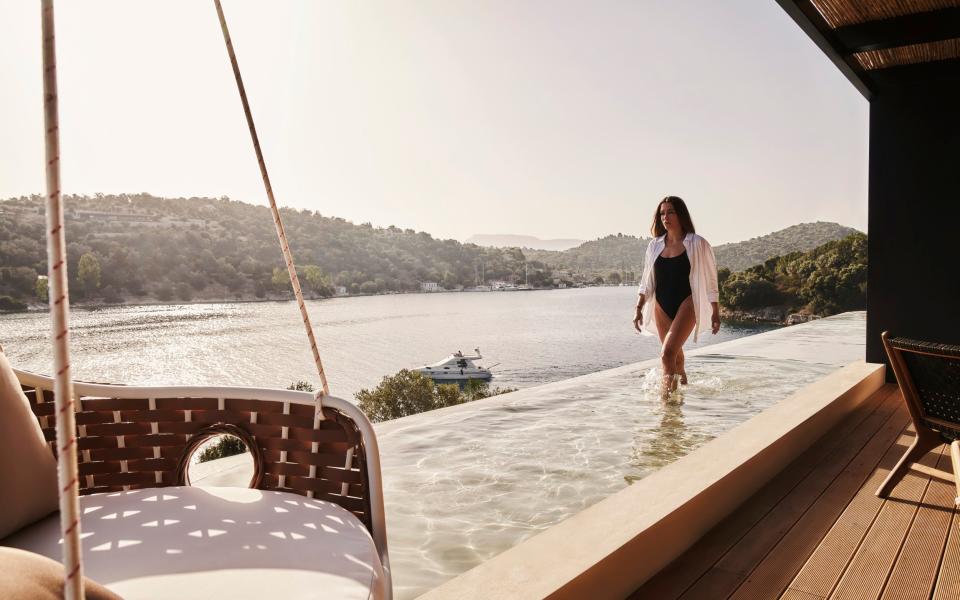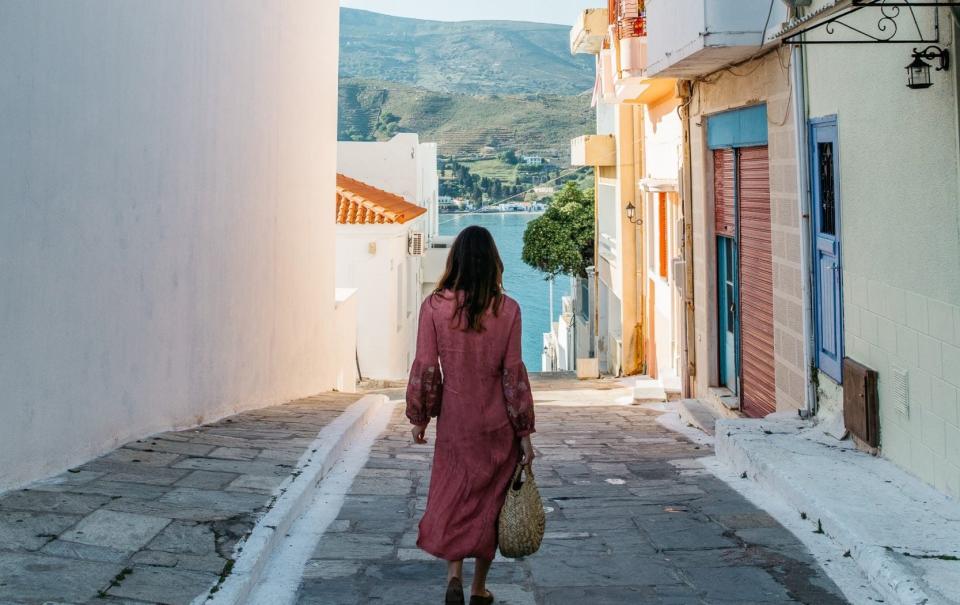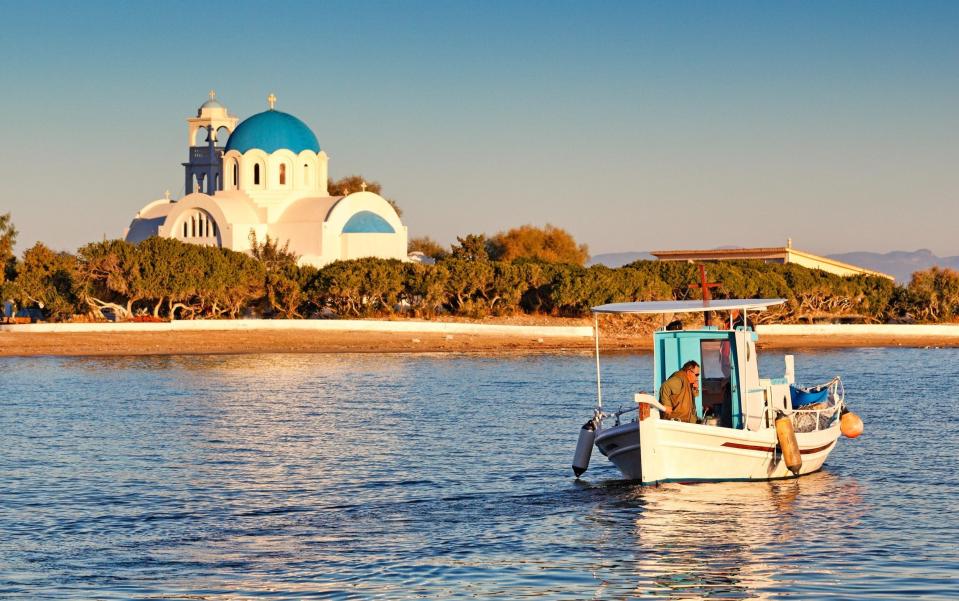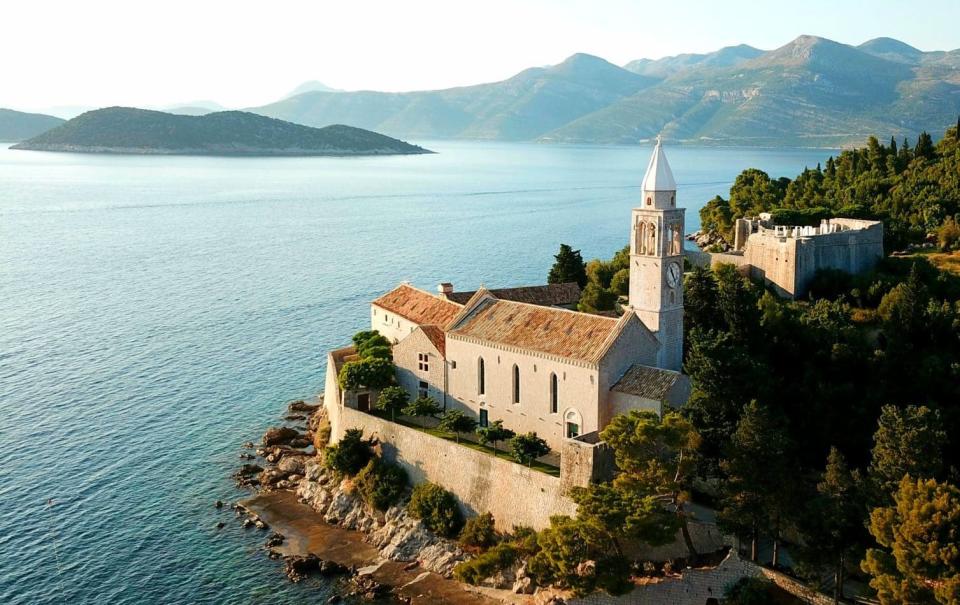Forget Santorini – these are the secret islands where Europeans take their holidays

Any secret worth knowing does not stay secret for long. In this age of social media, a destination can go from under-the-radar gem to over-touristed hotspot in a trice, particularly when that destination is a Mediterranean island. It’s hard to believe that just over a decade ago, Santorini was still relatively little known, before direct flights and influencers made it one of the most photographed, crowded places in Europe.
Are there any islands left in the Mediterranean which aren’t overtouristed and overpriced, especially in summer? You have to wonder: if an island is still a secret then surely, when Europe’s shores are so highly coveted by so many, is it really worth knowing?
And yet. Ask an Italian where they go on holiday, or where in-the-know Athenians spend summer. There are around 10,000 islands in the Mediterranean – 6,000 of which are Greek. Much as we love our favourites – Majorca, Ibiza, Corfu, Mykonos – there is something to be said for looking beyond them, to the small, obscure and offbeat.
Perhaps they are obscure simply due to geography: there’s no airport, so you have to make the extra effort, take a ferry, decipher unfathomable timetables. Perhaps they lack sandy beaches, or a fancy hotel, or nightlife – off-putting for some. And sometimes the reason is sociological, which only adds to its curious allure – the Italian island recently vacated by military troops, for example, or the Greek island long populated by seafarers who jealously guarded their wives from the temptations of strangers while they were away at sea, by keeping outsiders firmly out.
These are the gems to dig out. Yes, getting there might require a little extra effort, but the journey is part of the adventure, and the rewards are gratifying – your own wild and beautiful shores, unspoiled fishing villages where life rambles slow and carefree, on an island that feels like your own personal discovery, disconnected from the real world.
Here are 10 secret islands worth knowing, and keeping to yourself:
La Maddalena, Sardinia
A wild outpost of the Costa Smeralda
When the Aga Khan discovered Sardinia’s sensational beaches in the 1960s, he made a billionaire’s playground of the Costa Smeralda. Yet just offshore, the Maddalena archipelago has escaped the flashy hotels and high prices of Sardinia’s north-east coast, flying under the radar – thanks mainly to the fact that, until 2008, the island was a nuclear base for the US Navy, which put paid to tourism and development and gave the place a cold, unwelcoming vibe at odds with its wild beauty.

And what wild beauty. The archipelago is a national park. Its beaches are the perfect distillation of Mediterranean dreaminess: secret coves of fine white sand, backed by aromatic thyme and slipping into bays of life-affirmingly bright water. Hire a boat and head out to the warm turquoise lagoons around uninhabited Budelli’s pink-sand shores.
La Maddalena is quite big (20 square miles), so a car is helpful (though not essential) for reaching the best beaches. From the main island you can drive across a causeway to the neighbouring island of Caprera, wilder still. Garibaldi retired here, and there’s a museum and a cove named after him. Hike on, past derelict forts and houses, across maquis-covered headlands, and scramble over the curved, Seychellois rocks to secret beaches where the water is so clear and turquoise it’s been called the “Italian Tahiti”. Beyond pristine Spiaggia del Relitto the fortress of Batterie di Punta Rossa is abandoned and atmospheric; rock roses grow in the cracks of the concrete, empty windows frame blue views of the sea.
In the town of La Maddalena, low-key restaurants and bars are concentrated around the port and town square. There are still no fancy hotels, but that may be a blessing, keeping the island on the downlow. Go soon, before that changes.
How to get there: Fly to Olbia. Drive or take a bus to Palau, then get the ferry to La Maddalena.
Where to stay: Rent a house from Airbnb, such as one of the restored houses in Cala Francese, or this four-bedroom seaside villa. Hotel Cala Lunga is a four-star beach resort with its own marina and two restaurants (doubles from around £200 B&B).
Meganisi
Timeless beauty in the Ionians
Sleepy Meganisi is an Ionian island from a bygone era – one imagines the Corfu that Gerald Durrell fell in love with, only in miniature. Promontories of cypress, olive and Jerusalem pine greenly coddle fjords of Ionian blue, glassy as a millpond, where underwater grottoes glow and sailing boats are moored off white-pebble beaches.

Aristotle Onassis was no stranger to Meganisi’s charms – he married Jackie Kennedy on neighbouring Skorpios, which he owned (and which is currently being turned into a luxury private-island resort). Yet Meganisi has resisted any infiltrations of glamour, plodding along at its own slow pace. Cows amble along the beaches; long-haired goats mingle with sun-worshippers on the rock platforms beside the sea.
In the quintessentially Greek hillside villages of Spartochori and Katomeri, pink bougainvillaea winds over colourful doors and windows; while the harbour of cute Vathi is as bustling as things ever get – charter boats moor at the jetty, their crews come ashore for lunch at waterside tavernas serving the freshest fish and bright salads, blue-painted chairs and parasols set out on the crazy-paved quay.
There are no fancy restaurants, no nightlife. Very little to do at all, in fact, which is exactly why families with younger children love it, and those seeking an escape from the frenetic pace of the real world.

How to get there: Fly to Preveza, drive/taxi/bus to Lefkada (25min), and then on to Nydri, where ferries sail to Meganisi.
Where to stay: The Thinking Traveller has 12 luxury villas on Meganisi, from £2,119 a week; Vintage Travel has villas from £575 a week. Simpson Travel has 10 villas on the island. Hotel-wise, the fairest of them all is Azur Retreat, contemporary pool suites terraced up the hillside (doubles from around £260 B&B).

Procida
Overlooked gem in the Bay of Naples
Remember when we were all so pleased with ourselves for finding out about Ischia, that “secret” island in the Bay of Naples unknown except to Neopolitans, Hollywood film stars and a gazillion elderly Germans who flock to take its healing thermal waters? Well Procida is that secret island’s even-more-secret little sister.
Rainbow-coloured Corricella is a 17th-century fishing port that’s as heart-meltingly pretty as anywhere on the Cinque Terre. High above the town sits a fortified clifftop citadel, and beyond it, ragged limestone cliffs plunge down to shores of dark sand.

Procida retains a lost-in-time quality that has led to it starring as the historic backdrop for films including The Talented Mr Ripley, Il Postino and Taylor-and-Burton’s Cleopatra. And yet despite its widescreen fame, the tiny (two square-miles) island remains mostly unheard of, at least since the 1700s – in previous centuries it has been a holiday hotspot for Ancient Greeks, aristocrats from Rome, Vandals, Goths, Saracens and the King of Spain.
Today, there’s a fresh energy riffling through its rosy-hued backstreets, thanks to a strong scene of artists, artisans and foodie innovators, which led to its being named Italy’s Capital of Culture last year. While Procida may lack the luxury spas, five-star hotels and designer boutiques of neighbouring Capri and Ischia, what you will find are a handful of good-quality places to eat, drink and sleep, run by locals and celebrating the superb produce and wine from the island itself and the fertile region surrounding it.
How to get there: Fly to Naples and hop on the Hydrofoil/ferry to Procida.
Where to stay: Boutique hotel San Michele has a clutch of lovely suites and the harbourside Il Pescatore restaurant (doubles from around £130 B&B).
Rab
The best beaches on the Dalmatian Coast
It’s a mystery why Rab is not – yet – one of the Mediterranean’s most-wanted islands. She’s a beauty, her ancient town a jumble of houses and belltowers clustered upon a peninsula, the terracotta roofs a pleasing contrast to the sea-green Adriatic, while the rest of the island is a geopark evergreen-carpeted in holm oaks. But the biggest draw of all are Rab’s show-stopping beaches – great, long crescents of pale gold sand disappearing into scoops of emerald water.

Walk or cycle the trails crisscrossing its interior to popular Rajska (Paradise) and the mile-long Sahara, or find your own favourite among dozens of coves. Pack your swimmers or just a towel – clothing is optional, thanks to King Edward VIII, who in 1936 went skinnydipping with Wallis Simpson off their yacht at Kandarola beach, sparking the trend for naturism in Croatia.
How to get there: Fly to Rijeka and take the ferry from Stinica on the mainland or Valbiska on Krk.
Where to stay: The King and Mrs Simpson stayed at the 1920s-built Imperial Grand Hotel, now part of the Valamar Collection (doubles from around £135, B&B).

Ponza
Lazio’s smart holiday escape
When Odysseus stepped on Ponza’s shores, he was seduced by Circe the sorceress – and the island has been seducing travellers ever since. Lost in the Tyrrhenian Sea between Naples and Sardinia, Ponza is where in-the-know Italians shift down a gear during summer. Rugged limestone cliffs soar above fingernail bays of dazzling sand and pebble – secret beaches reached only by boat or an intrepid scramble down the rock. The sea is so clear you can see the rocks below when you swim, its colour shifting from pale green to inky blue.

There are easier-to-reach, family friendly beaches, too: Cala Feola with its beach bar and jetty, the cove forming a harbour full of boats; wide Frontone has sun loungers set in its rough sand in high summer – and while they may fill up in August, the island never feels over-run, thanks to the absence of an airport.
The colourful port is a gentle haven after the drama of the landscape, and painted the shades of an artist’s palette: ochre, lemon yellow and deep Cadmium red. Though resolutely laidback, there’s no shortage of smart boutiques and restaurants (waterside Acqua Pazza has a Michelin star) catering to the well-heeled Romans and Neopolitans who would rather keep Ponza their secret.
How to get there: Fly to Rome. Train to Anzio Colonia, then hydrofoil or car ferry to Ponza.
Where to stay: Hotel Chiaia di Luna is Ponza’s best hotel, its terraces of pastel casas, swimming pool and excellent restaurant set high above the bay where Odysseus landed (doubles from around £100 B&B). Atmospheric Hotel Torre dei Borboni is a gem of a three-star (doubles from around £70 B&B).
Andros
Affluent Cyclades enclave without the glitz
The Greek shipowners who built their mansions on Andros in the early 20th century blessed this Cyclades gem with an affluence that enabled it, for a long time, to cock a snook to outsiders.
It still feels like early days for tourism. Unlike Santorini and Mykonos, the headline acts of the Cyclades whose direct flights bring ever-growing crowds to their ever-glitzier hotels, Andros’s charms are quieter and slower, and remain largely the preserve of shipping magnates and the cognoscenti of Athens, two hours away by boat.

No wonder they want to keep it on the down-low. Unique to this archipelago, Andros has a lush mountainous interior where rivers spring from the ground bringing verdant life – lush forests, orchards, citrus groves – as they cascade through the hillsides into pools deep enough to swim in. The Andros Route trail runs through it, 60 miles; you can walk the island top to toe in 10 days. Otherwise, hire a 4x4 to explore; the roads peter out into rough tracks before they reach the beaches, which are stunning: isolated, uncultivated, sunlounger-free shores of fine, pale sand (another rarity in the Cyclades) and the most unbelievably blue sea.
Its main town of Chora is unexpectedly grand with its neoclassical city hall and houses with doric-columned porticos, and its various cultural spaces include a progressive Museum of Contemporary Art and an open-air amphitheatre that hosts arts performances in August.

How to get there: Fly to Athens; transfer (bus/taxi, 20 mins) to Rafina; take a ferry to Andros (2hr); or fly to Mykonos then ferry/Sea Jet from Tourlos port to Andros (1hr+).
Where to stay: Melissés is a gorgeous retreat with an emphasis on the produce and flavours of Andros; owner Allegra Pomilio (Alain Ducasse trained) leads cooking classes and foodie tours (from around £300 a night). Meanwhile, Onar is a collection of minimal (but chic) stone cottages, plus restaurant, bar and pool, behind dazzling Ahla beach built by shipbroker and magnanimous host Mateo Pantzopoulos (cottages from around £210, B&B). Alternatively, find good-value rentals at androsbnb.gr.
Pantelleria
Natural spa retreat in the Med’s deep south
Before the 2015 Tilda Swinton film A Bigger Splash, nobody had heard of the Italian island of Pantelleria. Even now, few could point to it on a map – far-flung down in the southernmost reaches of Europe, closer to Tunisia than to Sicily.

It’s known as the Black Pearl of the Mediterranean for its dark volcanic rock, and its sun-baked, windswept landscapes made a fine backdrop for the sexual tensions of the film – and, in real life, provide an offbeat refuge for A-listers (among them Sting, Truman Capote and Giorgio Armani) who choose Pantelleria precisely because it lacks beaches and thus hordes of holidaymakers.
Pantelleria requires more work. Instead, locals and visitors swim off the rocks or in thermal pools, and indulge in the island’s spa therapies: slathering themselves in skin-softening sulphurous mud in the Mirror of Venus lake, and detoxing in the natural sauna at Benikula Grotto.
How to get there: Fly to Pantelleria from the UK via Sicily.
Where to stay: Rent a dammuso (domed stone dwelling) on the Tenuta Borgia estate – Swinton’s home in A Bigger Splash (from around £685 a week). Or check into Sikelia, a chic, 20-suite hillside hideaway (suites from around £310 B&B).
Agistri
Easygoing family-holiday find near Athens
Hydra is the poster girl for the Saronic Islands, a superstar hangout since the 1960s when its tumble of pale houses captivated Leonard Cohen and his artsy cohort. En route to Hydra from Athens, meanwhile, the fellow Saronic island of Agistri remains little-visited by celebrities or British holidaymakers, despite being less than an hour from Piraeus. Instead of a photogenic harbour and boutique hotels, it lures with beaches and its easygoing way of life.

In the village of Skala, waterside tavernas are strung with fishing nets and octopus drying in the sunshine, and a blue-domed church presides behind a curve of sand shelving into iridescent shallows.
How to get there: Fly to Athens, ferry from Piraeus port (from 45m; directferries.co.uk).
Where to stay: Adults-only Saronis is charming, its sunny taverna the first on the island (doubles from around £65). Families might try Rosy’s Little Village; its simple rooms sleep up to five (doubles from around £60, room only). Olympic Holidays offers a week’s holiday on Agistri from around £800pp B&B at the three-star Oasis Beach Hotel & Spa, including flights.
Lopud
Barefoot and car-free offshore from Dubrovnik
An hour’s sail transports you from Dubrovnik’s thronged walled city and urban beaches to laidback Lopud in the Elaphite archipelago. The boat drops you at its harbour – delightfully small, just a smattering of honey-coloured stone buildings drowsing in the sun – and once the ferry has chuntered away the car-free island falls peaceful again. A walk up and over its forested hinterland brings you to Sunj beach, a half moon of sand and green water, one of the best in all Croatia, with a couple of bamboo-thatched beach bars for sundowners and salads.

Otherwise, the action’s all back in Lopud harbour – that is, a handful of unpretentious bistros beside the water, serving the freshest lobster and langoustine for a fraction of the price of other Mediterranean rivieras.
How to get there: Fly to Dubrovnik and take the ferry (from 35m) from the port.
Where to stay: There’s one large resort on Lopud’s otherwise unspoilt coastline, Lafodia Hotel (doubles from around £130 B&B). Otherwise, rent an apartment or villa (vrbo.com or airbnb.com); or for something super-special, the five-bedroom Lopud 1483 is an exquisitely restored monastery filled with the owner’s amazing art collection (price on request, through akvillas.com).
Favignana
The Sicilian island ruled by fish
Leave Taormina to the American heiresses and honeymooners, and go in search of Sicily’s wilder spirit, found 10 miles off its western shores in the Egadi archipelago. Its three inhabited islands are Levanzo, mountainous Marettimo, and, the biggest of them, Favignana.
Life centres around the harbour in Favignana village, all blue and white – the painted fishing boats bobbing on the water, the side streets lined with blue-shuttered houses. Fishermen at the port can take you around the island by boat; otherwise rent a bicycle or scooter to explore the scrubby landscape of thyme and purple-flowering borage, punctuated with olive trees and the green spikes of aloe. Rising up at the island’s centre is the abandoned fort of Santa Catarina, eagles riding the thermals above.

Easy-cycling tracks run from cove to cove, the island fringed with sandy limestone the colour of salted-caramel gelato. The locals know where to find slivers of sand (try Cala Azzurra), or else dive off the rocks into bright waters.
Visitors are few, and almost exclusively Italian, who hop over by hydrofoil from Trapani, perhaps to snorkel, dive, or relax into the slow pace of life. Until recently the archipelago had always depended on tuna, not tourism, for its wealth – Favignana was once the tuna capital of the world, and in the 15th century was ruled by the “Baron of Tuna”. Now the Egadi islands form part of the largest protected marine reserve in the Mediterranean, whose corals and sea grasses harbour varied underwater life; besides tuna swim sea turtles, dolphins, sharks, manta rays, and the rare monk seal in the extraordinarily clear waters that surround the islands.
How to get there: Fly to Trapani (Ryanair flies direct) and take the Hydrofoil/ferry to Favignana.
Where to stay: B&B La Casa dell’Arancio has vaulted rooms of Moorish tiling – a nod to the North African coast not 100 miles away (two nights from around £160). Dimora Cala del Pozzo and Dimora dell’Olivastro are a pair of stone farmhouse hotels: eight-bedroom Cala del Pozzo, 300 steps from the sea; and six-bed, sienna-painted Olivastro in the hills (doubles from around £160).
This article was first published in June 2023 and has been revised and updated.


